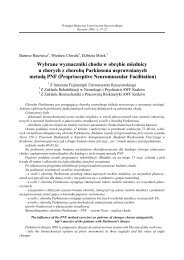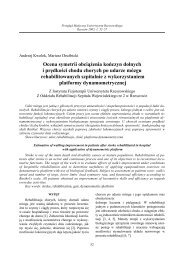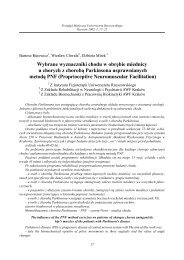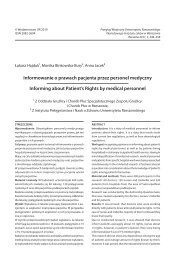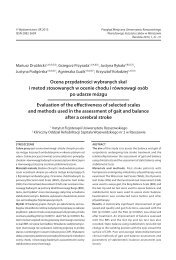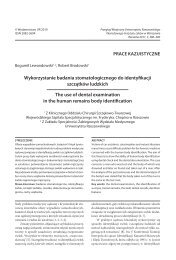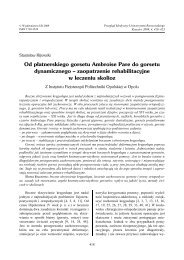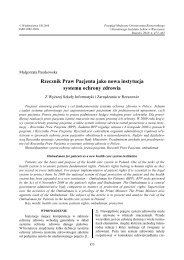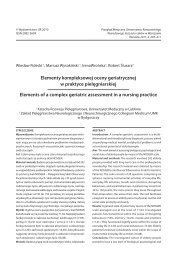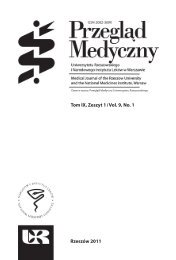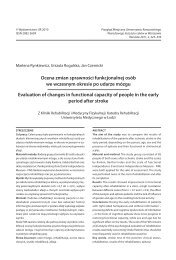Ocena chodu chorych z niedowÅadem poÅowiczym po udarze mózgu ...
Ocena chodu chorych z niedowÅadem poÅowiczym po udarze mózgu ...
Ocena chodu chorych z niedowÅadem poÅowiczym po udarze mózgu ...
You also want an ePaper? Increase the reach of your titles
YUMPU automatically turns print PDFs into web optimized ePapers that Google loves.
© Wydawnictwo UR 2010<br />
ISSN 1730-3524<br />
Przegląd Medyczny Uniwersytetu Rzeszowskiego<br />
Rzeszów 2010, 2, 152–159<br />
Mariusz Drużbicki 1,2 , Grzegorz Przysada 1,2 , Krzysztof Kołodziej 1,2 ,<br />
Justyna Rykała 1 , Justyna Podgórska 1<br />
<strong>Ocena</strong> <strong>chodu</strong> <strong>chorych</strong> z niedowładem <strong>po</strong>łowiczym<br />
<strong>po</strong> <strong>udarze</strong> mózgu z wykorzystaniem<br />
Wisconsin Gait Scale – doniesienie wstępne<br />
1 Z Instytutu Fizjoterapii Wydziału Medycznego Uniwersytetu Rzeszowskiego<br />
2 Z Klinicznego Oddziału Rehabilitacji z Pododdziałem Wczesnej Rehabilitacji<br />
Neurologicznej Szpitala Wojewódzkiego nr 2 w Rzeszowie<br />
Wstęp. Uszkodzenie ośrodkowego układu nerwowego <strong>po</strong>wstałe w wyniku udaru jest przyczyną utraty<br />
sprawności ruchowej i <strong>po</strong>znawczej. Udary mózgu cechuje duży stopień niepełnosprawności, a <strong>po</strong>wstałe<br />
zaburzenia <strong>chodu</strong> wpływają na istotne <strong>po</strong>gorszenie jakości życia. Analiza <strong>chodu</strong> stanowi konieczny<br />
element badania i oceny funkcjonalnej <strong>chorych</strong>. W codziennej praktyce klinicznej konieczne jest<br />
stosowanie prostych metod oceny <strong>chodu</strong>. Najczęściej bazują one na oglądaniu i opisie lub <strong>po</strong>miarze<br />
parametrów czasowych (prędkość, dystans). Rodriques i wsp. z Uniwersytetu Wisconsin opracowali<br />
skalę stosowaną w ocenie zaburzeń <strong>chodu</strong> u pacjentów z hemiplegią <strong>po</strong> <strong>udarze</strong> mózgu, jak również monitorowania<br />
efektów rehabilitacji.<br />
Cel. Celem pracy jest prezentacja skali oceny <strong>chodu</strong> Wisconsin oraz przedstawienie możliwości jej<br />
zastosowania w grupie <strong>chorych</strong> z niedowładem <strong>po</strong>łowiczym <strong>po</strong> <strong>udarze</strong> mózgu.<br />
Materiał i metoda. Badanie przeprowadzono w grupie <strong>chorych</strong> z niedowładem <strong>po</strong>łowiczym <strong>po</strong> <strong>udarze</strong><br />
mózgu, leczonych w oddziale rehabilitacji. Kwalifikowano <strong>chorych</strong> samodzielnie chodzących, bez<br />
zaburzeń funkcji <strong>po</strong>znawczych i chorób ortopedycznych zaburzających chód. Do badania włączono 10<br />
<strong>chorych</strong>. Średni wiek badanych wynosił 60,7 (SD = 8,47) lat. Chorzy byli w rożnym okresie od zachorowania.<br />
Oceniano chód za <strong>po</strong>mocą Wisconsin Gait Scale, prędkość <strong>chodu</strong> w teście drogi na dystansie<br />
10 metrów, stopień niedowładu kończyny dolnej wg skali Brunnström. Wisconsin Gait Scale składa się z<br />
14 obserwowalnych, <strong>po</strong>wiązanych z objawami klinicznymi zaburzeń kom<strong>po</strong>nentów <strong>chodu</strong>, <strong>po</strong>dzielonych<br />
na cztery <strong>po</strong>dskale. Zakres punktacji mieści się w granicy od 13,35 do 42 pkt. Wyższym wartościom<br />
punktowym od<strong>po</strong>wiadają większe zaburzenia <strong>chodu</strong>. Chód <strong>chorych</strong> rejestrowano za <strong>po</strong>mocą dwóch<br />
kamer w płaszczyźnie czołowej i strzałkowej.<br />
Podsumowanie. Wstępne obserwacje wykazały, iż wykorzystywana w pracy skala Wisconsin jest<br />
przydatna w programowaniu i ocenie efektów rehabilitacji u <strong>chorych</strong> <strong>po</strong> <strong>udarze</strong> mózgu. Uzyskane w<br />
skali wyniki korelują z obiektywnym testem <strong>chodu</strong> i stopniem nasilenia niedowładu. Konieczne jest przeprowadzenie<br />
dalszych badań nad oceną rzetelności – zgodności i <strong>po</strong>wtarzalności stosowanej metody.<br />
Słowa kluczowe: udar mózgu, chód, rehabilitacja, Wisconsin Gait Scale<br />
Gait evaluation with Wisconsin Gait Scale of patients with hemiparesis after stroke<br />
Introduction. Damage to the central nervous system caused by stroke is a reason of motor and cognitive<br />
functions impairment. Brain stroke is characterized by high level of disability moreover originated<br />
gait disorders influence on deterioration in quality of life. Gait analysis is necessary examination<br />
element and functional assessment of gait. In everyday clinical practice using of simple gait evaluation
method is essential. They are mostly based on watching and describing or measurement of time parameters<br />
(e.g. velocity, distance). Rodriques et al. from the University of Wisconsin developed scale<br />
which can be used to evaluate the gait problems experienced by a patient with hemiplegia after stroke<br />
as well as to monitor the effectiveness of rehabilitation training.<br />
Aim. The aim of the study is to present Wisconsin Gait Scale and showing <strong>po</strong>ssibilities for its use to<br />
assess patients with hemiplegia after brain stroke.<br />
Materials and methods. The study included a group of patients with hemiplegia after brain<br />
stroke treated in the rehabilitation ward. Patients were enrolled according to the following inclusion<br />
criteria: ability to walk independently with or without a walking device, cognitive ability to follow the<br />
instruction, no orthopaedic co-morbidities influencing on gait. 10 subjects were included to the study<br />
with the mean age of 60,7 in different period after stroke. Gait was assessed using: Wisconsin Gait<br />
Scale, velocity of walking on 10 metres distance and Brunnström Scale. Wisconsin Gait Scale consists<br />
of 14 observable variables that measure clinically relevant com<strong>po</strong>nents of gait which are grouped in 4<br />
subscales. Total score range from 13,35 to 42. Higher result means that patent is characterized by more<br />
severe gait impairments. Subjects were videotaped using 2 cameras, which provided lateral, anterior<br />
and <strong>po</strong>sterior view.<br />
Conclusion. Preliminary observation showed that Wisconsit Gait Scale is useful tool which gives<br />
results helping in rehabilitation planning and assessing changes over time during rehabilitation training<br />
in patients after brain stroke. There were significant correlations between WGS score objective gait<br />
velocity and Brunnström recovery stage. It is necessary to provide further validation (interrater an<br />
intrarater reliability (conformity), repeatability) for Wisconsin Gait Scale.<br />
Key words: brain stroke, gait, rehabilitation, Wisconsin Gait Scale



